“Zunin said to Rabbi Akiva: my heart and your heart know that there is no substance to idol worship. Nevertheless, don’t we see people who go with broken limbs to worship idols and come back when they are whole? What is the reason?”(Avodah Zarah 55a)
Faith healers, witch doctors, alternative alternative medicine – everyone has a story about someone who was deathly ill and was healed in an unconventional, and perhaps heretical way. Zunin is referring to the phenomenon, widespread in ancient times as well as today, of people with no hope going to some kind of healer and having a miracle cure. Without getting into the theology of the story, what kind of healing places is Zunin talking about?
In Greek and Roman culture the god of medicine and health was known as Asclepius. He was often depicted with a staff with a snake twirled around it, a symbol that is used today by health officials worldwide. Asclepius, as well as his daughters Hygeia and Panacea, was thought to have the power to heal. Remains of more than three hundred healing temples, known as asclepions, have been found in the Greek and Roman world. The healing process had some similarities to spas and mental health facilities today. First one had to undergo “catharsis,” a purifying experience with baths and a special diet. Then there was a sleeping regimen where the cure appeared in a dream. Famous ancient doctors like Hippocrates and Galen trained in asclepions.
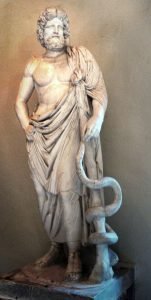
Michael F. Mehnert, CC BY-SA 3.0 <https://creativecommons.org/licenses/by-sa/3.0>, via Wikimedia Commons
The invalid who visited an asclepion was going for the health regimen but also presumably believed in the god behind it all, Asclepius. The Gemara focuses on the idolatry involved, more than the medicine, such as it was. That people looked to miraculous intervention for healing is apparent in two fascinating stories in the New Testament, both in the Gospel of John. Both involve pools, which we usually think of as mikvaot for ritual purification, but perhaps they were more than that and were used for healing.
In both New Testament stories, Jesus acts as the healer. In John chapter nine, he encounters a blind man. After putting mud and spit on the man’s eyes, he tells him to go bathe in the Shiloach pool in Jerusalem. The man’s sight is restored but the Rabbis are not happy. They do not like that Jesus healed on Shabbat, and perhaps more pertinent to our Gemara, they question if the whole story is a scam:
“Some of the Pharisees said, “This man is not from God, for he does not keep the Sabbath.” But others asked, “How can a sinner perform such signs?” (John 9:16)
The more famous story takes place in John chapter 5. Here Jesus heals an invalid but instructs him NOT to use the pool with the healing waters, but rather to walk unaided:
“2 Now there is in Jerusalem near the Sheep Gate a pool, which in Aramaic is called Bethesda and which is surrounded by five covered colonnades. 3 Here a great number of disabled people used to lie—the blind, the lame, the paralyzed. 5 One who was there had been an invalid for thirty-eight years. 6 When Jesus saw him lying there and learned that he had been in this condition for a long time, he asked him, “Do you want to get well?”7 “Sir,” the invalid replied, “I have no one to help me into the pool when the water is stirred. While I am trying to get in, someone else goes down ahead of me.”8 Then Jesus said to him, “Get up! Pick up your mat and walk.” 9 At once the man was cured; he picked up his mat and walked.” (John 5)
Like the preceding story, this one is also associated with a particular pool in Jerusalem. While the Shiloach is in the south of the city, at the beginning of the Pilgrims’ Road leading up to the Temple Mount, this pool is in the north, in the newer area added to the city, Bezetha (see here). The New Testament calls these pools the Bethesda pools, in Hebrew בית חסדא, and describes them as having five colonnades. An alternate name for this pool is connected to the fact that it is near the Sheep Gate (a name from the book of Nehemiah); it was called the Sheep Pools, בריכות הצאן, perhaps where sheep were washed before being brought into the Temple. We are talking about the northeastern corner of the Temple Mount, a place that is near the Bezetha Valley which run north to south and was used to collect water already in First Temple times.
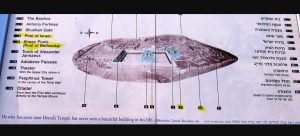
Daniel Ventura, CC BY-SA 4.0 <https://creativecommons.org/licenses/by-sa/4.0>, via Wikimedia Commons
We know that this area had two large reservoirs. One, the Birket Yisrael, was right against the northern Temple Mount walls:
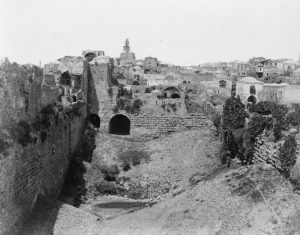
Library of Congress: Library of Congress, Public domain, via Wikimedia Commons
The other, our Bethesda Pools, are two enormous pools that today are located on the grounds of an ancient church, St. Anne’s, right next to Lions’ Gate. While the current church is from Crusader times, there are remains of a Byzantine church built around the two pools. They are there because of the story in John. The pools are unusual in that they are both enormous (each one about fifty by forty meters) and they are connected, but with a barrier in the middle. They are surrounded by four walls, and the fifth one is the barrier, hence five colonnades. Shimon Gibson who has excavated there says that the northern pool was a reservoir, what the Rabbis call an otzar, and the southern pool was a vast communal mikveh, fed by the otzar. Steps leading down to the southern pool also have wide landings, which fits with the story of the invalid waiting (im)patiently for his turn to go into the water.

Southern pool on the left, northern on the right, barrier with remains of Byzantine church in the middle
Aaadir, CC0, via Wikimedia Commons
After the Temple was destroyed, the pools kept on being used, first as a pagan shrine and then a Christian holy site. Gibson found many offerings around the pools, some of them feet or other limbs, presumably to thank the gods for restoring mobility. This fits beautifully with the Mishnah:
“If one found an object in the figure of a hand or in the figure of a foot, these are forbidden, as objects similar to those are worshipped.” (Mishnah Avodah Zarah 3:2)
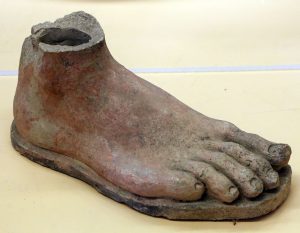
Sailko, CC BY 3.0 <https://creativecommons.org/licenses/by/3.0>, via Wikimedia Commons
The Bethesda pools went from being a mikveh for ritual purification, to an asclepion for healing. But perhaps even during Second Temple times there was a blurring of the lines and people thought that the mikveh could function like an asclepion since it already had the purifying waters. Otherwise why would an invalid come to be healed there? The fascinating parts of the story are the responses of both Jesus and the Rabbis. Jesus seems in this story to be polemicizing against healing waters, although in the later story at the Shiloach he uses those waters to heal. The Rabbis focus on the Shabbat desecration but are also skeptical that Jesus, a sinner, could heal people. Perhaps this story is an earlier precursor to Zunin’s question: we know that this is idolatry, so why does it work?
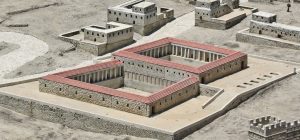
Bethesda pools in the Holyland model of Second Temple Jerusalem
Ariely, CC BY 3.0 <https://creativecommons.org/licenses/by/3.0>, via Wikimedia Commons










